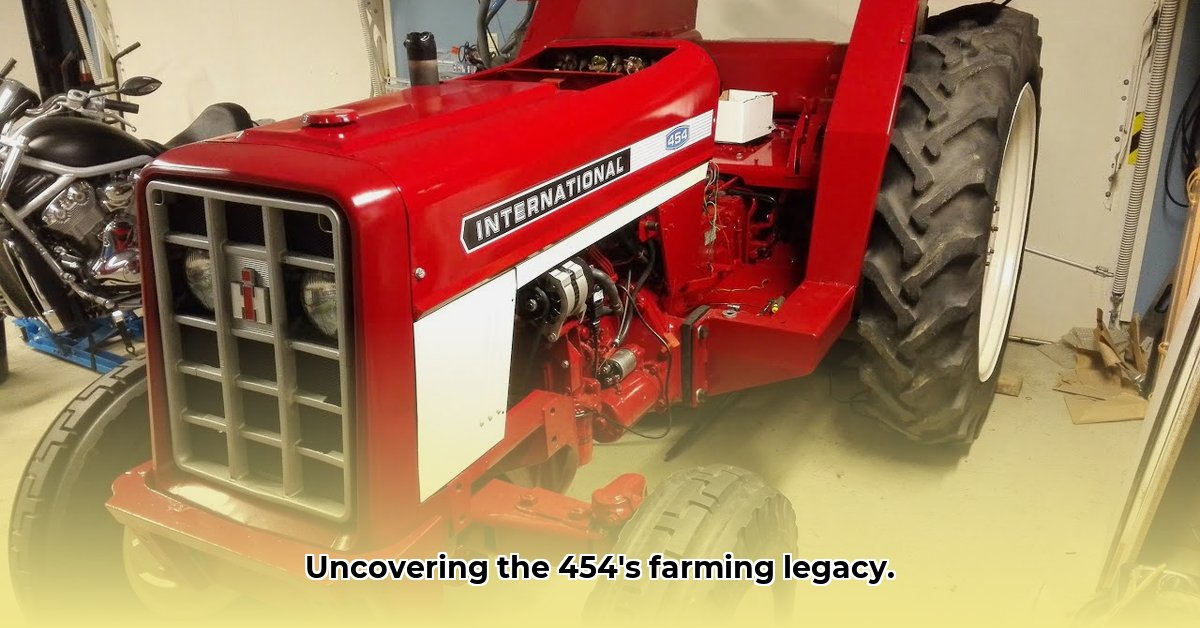
454 International Tractor: A Legacy of Sustainable Farming?
The International Harvester 454 tractor, a prominent agricultural machine of the 1970s, offers a compelling case study in the evolution of farming technology and its implications for sustainable agriculture. Produced between 1970 and 1977, the 454's production numbers, ranging from a few hundred initially to over 8,000 by 1973, reflect its significant impact on agricultural mechanization. For more on older International Harvester models, see this helpful resource. This article will analyze the 454's design, historical context, and sustainability implications, comparing it to modern agricultural practices.
The 454 International Tractor: A Mechanical Workhorse
The 454 represented a significant technological advancement in its time. Its robust design and availability in both gasoline and diesel models catered to diverse farming needs and reflected the energy landscape of the era. However, analyzing its impact on sustainability requires careful consideration of factors that weren't as closely scrutinized during its production. Did increased efficiency come at an environmental cost? This question forms the core of our analysis.
Under the Hood: Technical Specifications and the 70s Farming Scene
The 454 offered various horsepower options, enabling farmers to tailor their choice to specific needs. Its substantial lift capacity significantly reduced manual labor, a considerable advantage in an era of predominantly manual farming. The tractor's impact on soil compaction and its greenhouse gas emissions, however, remain largely unknown due to a lack of comprehensive data. This information gap significantly hinders a complete sustainability assessment.
Sustainability: Putting the 454 to the Test
Assessing the 454 through a modern sustainability lens reveals significant limitations. While it undoubtedly enhanced agricultural productivity, the environmental considerations prevalent today were largely absent during its development. Crucially, we lack detailed data on its fuel efficiency, greenhouse gas emissions, and effects on soil compaction. These data limitations prevent a definitive assessment of its overall environmental impact. Further research is urgently needed.
Then and Now: A Comparison of Tractors
A direct comparison with modern tractors is challenging due to incomplete data on the 454's fuel consumption and emissions per unit of work (e.g., gallons/liters per acre). Modern tractors, however, leverage technological advancements such as precision farming techniques (GPS guidance, variable rate application) and electronic fuel injection to enhance fuel efficiency and reduce emissions. This demonstrates significant progress in sustainable agriculture technology. However, a thorough cost-benefit analysis considering the initial investment costs of modern tractors compared to procuring a used 454 is also necessary for a comprehensive assessment.
What the 454 Teaches Us Today
Despite data limitations, the 454 provides valuable insights. It underscores the evolution of agricultural technology and the shifting priorities between raw productivity and environmental stewardship. Its design and operating characteristics can inform the development of more sustainable machinery. The contrast between the 1970s focus on mere productivity and today’s emphasis on minimizing environmental impact highlights the ongoing journey towards truly sustainable agriculture.
Future Research: Uncovering the 454's True Impact
To fully assess the 454's impact, further research is critical. This includes gathering data on fuel consumption and emissions under various conditions, comparing its lifespan and repairability to modern tractors, and meticulously analyzing its life-cycle costs and environmental footprint. Such research will provide an essential context for evaluating its role within the evolving landscape of sustainable agriculture.
Key Pivotal Points:
- The International Harvester 454, produced between 1970 and 1977, significantly impacted agricultural mechanization.
- A comprehensive sustainability assessment is hampered by a lack of readily available data on fuel efficiency, emissions, and soil compaction.
- The 454 highlights the shift in priorities from raw productivity to environmentally conscious farming practices.
How to Compare International Harvester 454 Fuel Efficiency to Modern Tractors
Comparing the fuel efficiency of a vintage International Harvester 454 to modern tractors presents a complex challenge. The 454, available in gasoline and diesel variants, represents a significant step in agricultural mechanization, but lacks the detailed fuel consumption data readily available for modern tractors.
Key Challenges for direct Comparison: The lack of precise fuel consumption data for the IH 454 under various workloads makes a direct comparison difficult. We can, however, make some inferences based on the knowledge that diesel engines generally exhibit better fuel economy than gasoline engines.
Factors influencing Fuel Consumption: Maintaining a well-maintained engine, operating conditions (terrain, tasks), implement use, and proper tire inflation all significantly impact fuel consumption in both vintage and modern tractors.
Modern Tractor Advantages: Modern tractors use advanced technologies like precision farming techniques, electronic fuel injection, and improved engine designs, contributing to substantially lower fuel consumption rates.
Beyond Fuel Efficiency: A holistic comparison must also include emissions (older tractors often had higher air pollution) and soil compaction (weight and design factors vary).
Sustainable Farming and Choice of Tractor: The choice between a vintage tractor and modern machinery involves considering factors such as scale of operation, budget, and sustainability goals. Modern tractors generally provide a much lower environmental footprint, but initial investment costs are significantly higher.